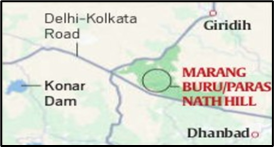Why in News?
The Jharkhand High Court directed the state government to enforce an existing ban on meat, alcohol, and other intoxicants on a sacred hill in Giridih district.
Known as Marang Buru to the Santal Adivasi community and Parasnath to Jains, the hill is a site of religious significance for both groups and has been at the center of a long-standing inter-community conflict.

What’s in Today’s Article?
- A Sacred Hill Revered by Two Communities
- An Old Conflict Over Sacred Rights
- Situation After Independence
A Sacred Hill Revered by Two Communities
- Jain Significance
- Parasnath Hill holds immense religious importance for Jains, as it is believed that 20 of the 24 tirthankaras, including Parshvanatha (after whom the hill is named), attained nirvana here.
- Today, the hill features over 20 Jain temples and pilgrimage sites, symbolizing its deep historical and spiritual roots in Jain tradition.
- Santal Significance
- For the Santal Adivasi community, the hill is known as Marang Buru or "Great Mountain" and is the abode of their supreme animist deity.
- It houses sacred sites like Jug Jaher Than and Dishom Manjhi Than, where vital rituals are performed.
- The hill also serves as a spiritual and cultural hub during the annual Hudur Durga festival in December.
- The tribal council Lo Bir Baisi convenes at its base to resolve major disputes.
- It was with a resolution of this council that the historic Santal Hul was launched in 1855.
- Led by Sidhu and Kanhu Murmu, the rebellion targeted the oppressive dikus (outsiders), including za- mindars, mahajans, and British officals.
- Source of Conflict
- The dual sanctity has made the hill a shared yet contested religious space between the two communities.
An Old Conflict Over Sacred Rights
- Historical Claims and Disputes
- While Jains claim that an ancient king once donated Parasnath Hill to their community, historical records challenge this.
- According to the 1957 Hazaribagh District Gazetteer, the oldest Jain temple on the hill dates only to 1765 AD.
- The formal dispute between the Santals and Jains over the hill was first documented in 1911, during the preparation of the record-of-rights.
- The Sendra Festival and Religious Friction
- A key point of contention is the Sendra festival—a three-day ritual hunt during the full moon of Baisakh, considered a rite of passage for Santal men.
- The hill, called Marang Buru by Santals, becomes the center of this religious and cultural practice.
- For Jains, who adhere strictly to non-violence and vegetarianism, this tradition is deeply troubling.
- Legal Battles and Customary Rights
- Early efforts by the Jain community to legally halt the hunting practice failed.
- In 1917, the Patna High Court dismissed the suit, terming the Jains’ grievance as “hyper sentimental.”
- Ultimately, the Privy Council—the highest court in British India—upheld the Santals’ customary right to hunt on the hill, recognizing their longstanding traditions.
Situation After Independence
- Loss of Constitutional Protections
- After India’s independence, the rights of Adivasis over Marang Buru began to decline due to increasing state control over forests and pressure from non-tribal communities (dikus).
- In 1972, the same year the Wildlife Protection Act was passed, Adivasi villages around the hill lost their Fifth Schedule status, stripping them of constitutional protections that allowed forest usage.
- Impact on Religious Practices
- This led to restrictions on traditional rituals, especially at Jug Jaher Than, the sacred Santal site.
- Between the 1970s and Jharkhand’s formation in 2000, Santals faced growing limitations on access and gatherings at the hill.
- Recent Government Directives and Legal Orders
- In 2023, the Ministry of Environment, Forest and Climate Change (MoEFCC) issued a memorandum banning alcohol, meat, and eggs within a 25 km radius of the hill—covering 99 mostly Adivasi villages—to honor Jain sentiments.
- This included restrictions in Anganwadi centers and primary schools.
- The Jharkhand High Court’s recent order enforced this directive.









